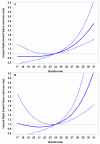Association of serum bicarbonate with risk of renal and cardiovascular outcomes in CKD: a report from the Chronic Renal Insufficiency Cohort (CRIC) study
- PMID: 23489677
- PMCID: PMC3701754
- DOI: 10.1053/j.ajkd.2013.01.017
Association of serum bicarbonate with risk of renal and cardiovascular outcomes in CKD: a report from the Chronic Renal Insufficiency Cohort (CRIC) study
Abstract
Background: The purpose of this study is to evaluate serum bicarbonate level as a risk factor for renal outcomes, cardiovascular events, and mortality in patients with chronic kidney disease (CKD).
Study design: Observational cohort study.
Setting & participants: 3,939 participants with CKD stages 2-4 who enrolled in the Chronic Renal Insufficiency Cohort (CRIC) between June 2003 and December 2008.
Predictor: Serum bicarbonate level.
Outcomes: Renal outcomes, defined as end-stage renal disease (either initiation of dialysis therapy or kidney transplantation) or 50% reduction in estimated glomerular filtration rate (eGFR); atherosclerotic events (myocardial infarction, stroke, or peripheral arterial disease); congestive heart failure events; and death.
Measurements: Time to event.
Results: Mean eGFR was 44.8 ± 16.8 (SD) mL/min/1.73 m(2), and median serum bicarbonate level was 24 (IQR, 22-26) mEq/L. During a median follow-up of 3.9 years, 374 participants died, 767 had a renal outcome, 332 experienced an atherosclerotic event, and 391 had a congestive heart failure event. In adjusted analyses, the risk of developing a renal end point was 3% lower per 1-mEq/L increase in serum bicarbonate level (HR, 0.97; 95% CI, 0.94-0.99; P = 0.01). The association was stronger for participants with eGFR >45 mL/min/1.73 m(2) (HR, 0.91; 95% CI, 0.85-0.97; P = 0.004). The risk of heart failure increased by 14% (HR, 1.14; 95% CI, 1.03-1.26; P = 0.02) per 1-mEq/L increase in serum bicarbonate level over 24 mEq/L. Serum bicarbonate level was not associated independently with atherosclerotic events (HR, 0.99; 95% CI, 0.95-1.03; P = 0.6) and all-cause mortality (HR, 0.98; 95% CI, 0.95-1.02; P = 0.3).
Limitations: Single measurement of sodium bicarbonate.
Conclusions: In a cohort of participants with CKD, low serum bicarbonate level was an independent risk factor for kidney disease progression, particularly for participants with preserved kidney function. The risk of heart failure was higher at the upper extreme of serum bicarbonate levels. There was no association between serum bicarbonate level and all-cause mortality or atherosclerotic events.
Keywords: Metabolic acidosis; cardiovascular morbidity; chronic kidney disease; serum bicarbonate.
Copyright © 2013 National Kidney Foundation, Inc. All rights reserved.
Figures




Comment in
-
Association of serum bicarbonate with clinical outcomes in CKD: could an increase in serum bicarbonate be a double-edged sword?Am J Kidney Dis. 2013 Oct;62(4):647-9. doi: 10.1053/j.ajkd.2013.07.001. Am J Kidney Dis. 2013. PMID: 24054938 No abstract available.
References
-
- Eustace JA, Astor B, Muntner PM, Ikizler TA, Coresh J. Prevalence of acidosis and inflammation and their association with low serum albumin in chronic kidney disease. Kidney Int. 2004;65(3):1031–40. - PubMed
-
- Yaqoob MM. Acidosis and progression of chronic kidney disease. Curr Opin Nephrol Hypertens. 2010;19(5):489–92. - PubMed
-
- Wesson DE, Simoni J. Increased tissue acid mediates a progressive decline in the glomerular filtration rate of animals with reduced nephron mass. Kidney Int. 2009;75(9):929–35. - PubMed
-
- Phisitkul S, Hacker C, Simoni J, Tran RM, Wesson DE. Dietary protein causes a decline in the glomerular filtration rate of the remnant kidney mediated by metabolic acidosis and endothelin receptors. Kidney Int. 2008;73(2):192–9. - PubMed
Publication types
MeSH terms
Substances
Grants and funding
- M01 RR-024986/RR/NCRR NIH HHS/United States
- U01DK061022/DK/NIDDK NIH HHS/United States
- U01 DK060963/DK/NIDDK NIH HHS/United States
- K23 DK087919/DK/NIDDK NIH HHS/United States
- U01DK060980/DK/NIDDK NIH HHS/United States
- U01DK061028/DK/NIDDK NIH HHS/United States
- UL1 TR000439/TR/NCATS NIH HHS/United States
- K24 DK062234/DK/NIDDK NIH HHS/United States
- U01DK060902/DK/NIDDK NIH HHS/United States
- M01 RR000042/RR/NCRR NIH HHS/United States
- M01 RR-000042/RR/NCRR NIH HHS/United States
- UL1 RR024134/RR/NCRR NIH HHS/United States
- U01 DK061028/DK/NIDDK NIH HHS/United States
- UL1 RR-025005/RR/NCRR NIH HHS/United States
- R01 DK072231/DK/NIDDK NIH HHS/United States
- U01DK060963/DK/NIDDK NIH HHS/United States
- UL1 RR025005/RR/NCRR NIH HHS/United States
- U01 DK060984/DK/NIDDK NIH HHS/United States
- U01 DK061021/DK/NIDDK NIH HHS/United States
- UL1 RR-024131/RR/NCRR NIH HHS/United States
- P30 GM103337/GM/NIGMS NIH HHS/United States
- U01 DK060980/DK/NIDDK NIH HHS/United States
- UL1 RR024131/RR/NCRR NIH HHS/United States
- R56 DK072231/DK/NIDDK NIH HHS/United States
- U54 GM104940/GM/NIGMS NIH HHS/United States
- M01 RR013987/RR/NCRR NIH HHS/United States
- U01 DK061022/DK/NIDDK NIH HHS/United States
- U01DK061021/DK/NIDDK NIH HHS/United States
- U01DK060984/DK/NIDDK NIH HHS/United States
- U01DK060990/DK/NIDDK NIH HHS/United States
- R01 DK081374/DK/NIDDK NIH HHS/United States
- M01 RR016500/RR/NCRR NIH HHS/United States
- U01 DK060902/DK/NIDDK NIH HHS/United States
- U01 DK060990/DK/NIDDK NIH HHS/United States
- UL1TR000439/TR/NCATS NIH HHS/United States
- M01 RR-16500/RR/NCRR NIH HHS/United States
- T32 DK007470/DK/NIDDK NIH HHS/United States
- UL1 RR-024134/RR/NCRR NIH HHS/United States
- UL1 RR024986/RR/NCRR NIH HHS/United States
- UL1 RR029879/RR/NCRR NIH HHS/United States
LinkOut - more resources
Full Text Sources
Other Literature Sources
Medical
Molecular Biology Databases
Research Materials
Miscellaneous

